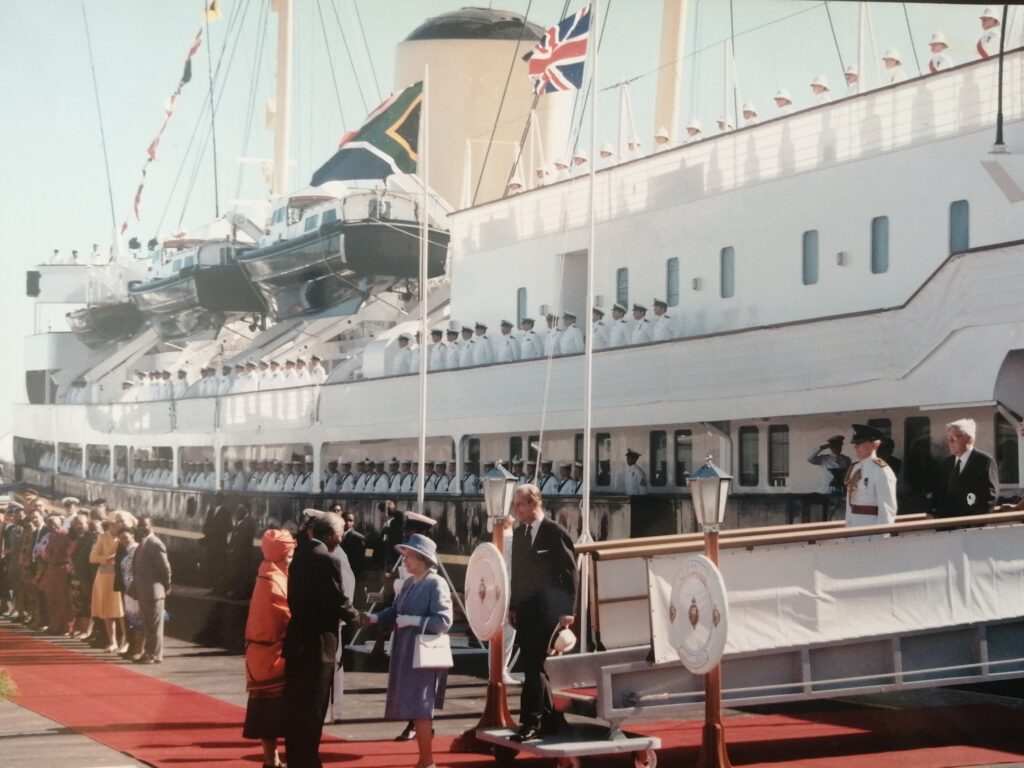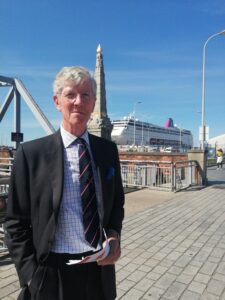 WHEN US Iraqi war hero General ‘Stormin” Norman Schwarzkopf toured the Her Majesty’s Yacht Britannia and saw her engine room’s white painted bilges, he was astonished.
WHEN US Iraqi war hero General ‘Stormin” Norman Schwarzkopf toured the Her Majesty’s Yacht Britannia and saw her engine room’s white painted bilges, he was astonished.
“OK – I’ve seen the display, where’s the real engine room?” he growled. Such a disbelieving reaction was music to the ears of Capt Hugh Daglish, seen left, the penultimate commander of Britannia, who lives in West Kirby, Wirral.
Perfection that represented a display of the best of British was the watchword aboard Britannia and her crew, termed ‘Royal Yachtsmen’, were determined to never let these standards slip. Capt Daglish said: “They were the perfect workforce and therefore very disappointed if I found anything wrong, but that was my job!”
At the time of writing, it is now almost exactly 26 years ago to the day that that Britannia, the UK’s last Royal Yacht was paid-off on 11 December, 1997.
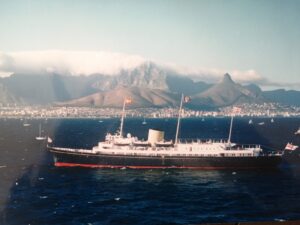
After a discreet interview onboard Capt Daglish, then aged 44 , was invited to become commander and served on Britannia from 1994-6, when the yacht took part in two hugely important Royal state visits to Russia and South Africa. The yacht is seen right in Table Bay, off Cape Town and in the main picture when President Mandela greeted Queen Elizabeth II on her arrival, in Cape Town, in March 1995. Overall command of the ship was by a Rear Admiral (a member of the Queen’s Household), then later by a Commodore with the commander in charge of operating the yacht.
“It was a great job offer and a great surprise. This was a unique experience and I’d have been mad not to take it, as the First Sea Lord had taken an interest in my career,” said Capt Daglish, “but colleagues warned me ‘if you mess it up your career will be ruined’!”
“It was said ‘There are officers on the royal yacht and royal yacht officers – one was good and one was bad. and I like to think I was the latter. But you had to win the confidence of a well-established and efficient crew through appropriate management and leadership.
“You felt you were in the Queen and Prince Philip’s home, especially when taking them on their annual 10 day August holiday around the Scottish Western Isles. It was a joy to see the Queen so happy on these cruises which were her only untimetabled days.
“The Admiral, the Queen and Prince Philip would decide which secluded beach to visit the next day and a message was sent to the bridge to anchor off the beach that night. In the morning a launch would be sent ahead to unload all the gear.
“It was a rare chance for the Queen to totally relax and read a book. Once a couple on a walk bumped into the Queen and the husband said, ‘Good morning, Your Majesty’ and his wife admonished him, saying ‘Can’t you leave the poor woman alone? Can’t you see she’s busy?’!”
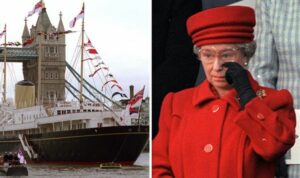 Indeed the Royal couple formed a profound bond with Britannia and Prince Philip, a former RN officer, took a deep interest in her overall design, as did the Queen in the yacht’s interior decor. Launched by the newly crowned Queen in 1953 at John Brown & Co’s shipyard on Clydebank, she was visibly upset at the yacht’s decommissioning ceremony in a rare show of public emotion, on a cold December day, in 1997.
Indeed the Royal couple formed a profound bond with Britannia and Prince Philip, a former RN officer, took a deep interest in her overall design, as did the Queen in the yacht’s interior decor. Launched by the newly crowned Queen in 1953 at John Brown & Co’s shipyard on Clydebank, she was visibly upset at the yacht’s decommissioning ceremony in a rare show of public emotion, on a cold December day, in 1997.
“The mystique of Royalty was a huge part of Britannia’s attraction to guests and she was a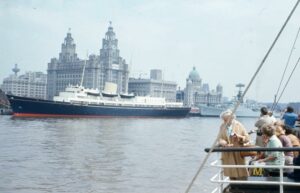 ‘honeypot’ for curious visitors, including four US presidents with countless contracts agreed aboard,” says Capt Daglish. One UK business repeatedly failed to get a top Japanese investor to meet its directors, until the tenth invitation was to a reception aboard Britannia and he immediately accepted.
‘honeypot’ for curious visitors, including four US presidents with countless contracts agreed aboard,” says Capt Daglish. One UK business repeatedly failed to get a top Japanese investor to meet its directors, until the tenth invitation was to a reception aboard Britannia and he immediately accepted.
In India in 1992 some £3 billion of contracts were signed with British companies aboard Britannia, and during a 1994 visit to South Wales for Prince Charles to promote the Prince’s Trust and inward investment £16 million were signed onboard in just three days, for example. The yacht played a major commercial role for the ‘British Invisibles’ – the organisation promoting UK financial services abroad.
“Everyone, including top politicians, wanted a tour of the ship. Once PM John Major asked a steward what he was doing in the Royal pantry and he replied, ‘I’m washing up and this is Neil Kinnock (then Leader of the Opposition) going down for the third time, sir!’.”
But all the perfect presentation came at a cost of very hard work to make the yacht look like she’d just steamed out of the builder’s yard. Capt Daglish says: “It was like a play, with a lot of behind the scenes activity which you don’t hear. What made it work? The crew’s dedication to service. They never let you down.
“The programme was rigorous and whatever was ordered happened as organised. The crew occupied spartan accommodation at the fore end of the ship and the Royal apartments were at the aft end. They weren’t palatial, even the chandeliers weren’t works of art, but there were numerous souvenirs and gifts displayed from Commonwealth and other countries.
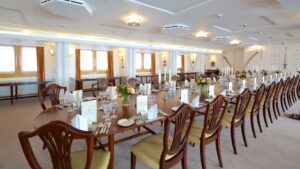 “The state receptions, such as that for President Mandela in South Africa, were fabulous and perfectly judged by the Foreign Office. There would be 86 guests seated in a U-shaped table with the Queen in the centre with her chief guest.
“The state receptions, such as that for President Mandela in South Africa, were fabulous and perfectly judged by the Foreign Office. There would be 86 guests seated in a U-shaped table with the Queen in the centre with her chief guest.
“In fine weather there would be a further reception for another 250 guests on deck. You had to be ready for Britannia to list when all the guests crowded the rails to watch the Royal Marines Beating the Retreat at the end of the evening!”
The UK could exert very potent soft power called ‘Naval Diplomacy’ through the highly visible presence of Britannia, with guests chosen by the Foreign Office. The yacht also appealed especially to poorer nations as she took care of all accommodation, security and most of the hospitality in the countries the Queen visited.
In Capt Daglish’s eyes Britannia’s landmark visit to St Petersburg in 1994, marking the end of the Cold War and the only time a reigning British monarch made a state visit to Russia, was a stark demonstration of the difference that remained between life in the West and Russia.
“It was a cold and dark November afternoon. The Queen and Prince Philip flew in from Moscow by the RAF Royal Flight and the first thing we heard was gloved clapping (the locals had not been allowed any closer to Britannia) as round the corner her Rolls-Royce appeared with the Royal couple illuminated inside.
“The following day President Yeltsin and his wife arrived in a fleet of 15 blacked out Zil limousines, with no applause, but plenty of security. Out of all the cars jumped these big fearsome heavies guarding Yeltsin!
“The Queen, unlike many heads of state, had no visible security – and look at the reception she got. She accepted the risk in order to connect with people. Back then the Russian people were full of optimism after the aberration of the previous 50 years.”
The Queen always had a welcome lunch with a new captain and each voyage attended one dinner in Britannia’s Wardroom: “It was a very special occasion and it was expected you wouldn’t ask the her daft questions such as ‘what’s it like to be Queen?’!”
There was a terrific camaraderie aboard and the yachtsmen could stay for as long as they wished, some served for 20 years or more. “They enjoyed the part they played in the glare of publicity. There was group pride in the whole experience, it was a self-sustaining co-operative society. But they were expected to behave and adhere to a strict dress code ashore.”
However, the efficiency was not po-faced, as a sense of fun was injected into this very hierarchical naval society whenever possible. For example, at a band concert on the forecastle at sea, after a lot of rough weather, Capt Daglish, had his rendition of the jazz standard Stormy Weather met with a bucket of water chucked over him.
“You have to ask was a royal yacht an anachronism, a throw-back to a different, earlier age? Few of the crew were over 40 years. They loved that ship and I don’t say that out of sentimentality. They thrived on smartness, punctuality, a code of behaviour, a sense of their own collective worth and service. Misbehaviour was not punished, it meant dismissal which was rare.
“I’d had a full career in warships and I was very, very lucky to have commanded Britannia for two years.”
Britannia Quirks
Although small, Britannia was built as an ocean going ship and steamed more than a million miles in 43 years, making 696 foreign visits and 272 in UK waters.
Britannia’s name did not appear on her hull, unlike almost every other ship in the world.
A product of her time, Britannia was a twin-screw turbine steamer with one rudder, which made her tricky to handle under five knots and while docking.
Before arrival in port, Britannia’s hull was hosed down offshore with fresh water, with the commander circling in a launch to check all saltwater smears were removed from her dark blue hull.
To ensure security Britannia was always accompanied by a warship when the Queen was onboard and which berthed nearby.
The main gangway was always angled at 22.5′ when the Queen was scheduled to go ashore, so the Navigator had to make his tidal predictions accurate.
On Royal Duty Britannia had to be perfect from stem to stern, with teak decks white, brass fittings burnished, paintwork and glossy woodwork deeply varnished, rigging taut, ropes coiled, awnings and weather cloths stretched and spotless over the rails.
All the propellers on the yacht’s lifeboats and launches were angled the same way when stowed on their davits (one blade up, two down).
The Royal Marines’ Beat the Retreat ceremony to end state receptions was timed at exactly 22 minutes 30 seconds.
There were 1,000 pieces of silverware, cutlery and crockery kept onboard.
On evening departure Britannia was floodlit with the Queen on deck and silently moved sideways (the yacht’s steam plant operated perfectly with no smoke, steam or noise) while towed by tugs out of sight on the far side.
There was no tannoy onboard and all yachtsmen wore gym shoes to minimise noise and be unnoticeable, as if in a stately home, cocooned away from the Royal apartments.
The construction cost was justified by a dual-role as a hospital ship during wartime. This never occurred. During the Falklands War her outdated furnace oil fuel would require a special tanker supply ship and PM Margaret Thatcher also wanted the yacht kept out of harm’s way.
She showed her value in 1986 when she rescued refugees from a difficult and violent situation in Aden and took them to safety.
Will there ever be another Royal Yacht?
HM Yacht Britannia’s decommissioning ceremony was one of the very few occasions when the HM Queen Elizabeth II’s mask slipped and she showed her emotions in public, clearly deeply upset at ship’s paying off, on 11 December, 1997.
In reality though, there was no need to pension off Britannia as she was one of the best maintained and well-built ships in the world, believes her penultimate master, Capt Hugh Daglish, “as her outstanding crew looked after with the care a proud owner would lavish on a vintage car.”
She was capable of many more years of service as the ultimate floating ambassador for the UK, representing the best of Britain and a unique diplomatic tool which no other nation could match.
Britannia was paid off at the end of John Major’s Conservative Government when Capt Daglish was already working on designs for a replacement while at Naval Home Command. However, this wasn’t on the list of priorities for incoming Tony Blair’s ‘New’ Labour government and the project was cancelled.
It might have been a problem that the Ministry of Defence funded Britannia, not the Royal Household, Foreign Office or Department of Trade and Industry all of which hugely benefited from her presence on the world stage. Cash was not ring-fenced for the yacht and thus she was vulnerable to defence cuts.
“The MoD didn’t get a penny out of Britannia and when discussing a replacement the bean counters thought only a crew of 30-40 was required, which was utterly ridiculous for a ship in this role, which required 271 officers and crew, said Capt Daglish.
“Decommissioning Britannia was not good news as we had to go through every man onboard to see how they could be redeployed. Nobody’s loyalty was rebuffed. The onboard clocks were all stopped at the time of her paying off at 12.15pm.”
Of course Britannia was not scrapped but has become one of Scotland’s top 10 paid for visitor attraction in Leith, Edinburgh. Capt Daglish initially could not face visiting her, but now feels enough time has elapsed and he reflected: “People’s curiosity and fascination is unabated!”
Yet in spite of the UK unsurprisingly remaining an island nation with a monarchy and Britannia having proved her incredible value over four decades, will there be another royal yacht?
Capt Daglish said: “If there is, it needs to be a Royal Yacht first and foremost, benefitting from that mystique if it is also to be a successful ‘flag ship’ for British diplomacy and commerce.”
Sadly, it seems Britannia will be the last of her kind after 337 years when the Dutch government presented HMY Mary to King Charles II in 1660. There’s simply no longer any government or royal desire to continue the tradition.

